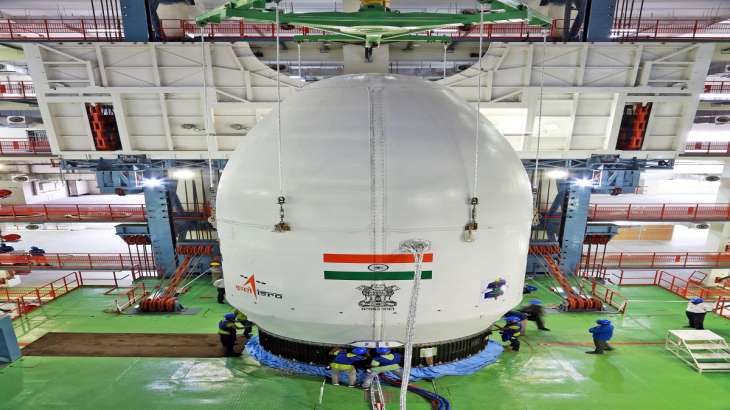
Chandrayaan-3 mission update: The Indian Space Research Organization (ISRO) today (July 5) mated the encapsulated assembly containing the Chandrayaan-3 spacecraft with its new heavy lift launch vehicle LVM 3 at the Satish Dhawan Space Center in Sriharikota.
Chandrayaan-3 is the follow-up mission to Chandrayaan-2, which demonstrated the full capability of safe landing and orbiting on the lunar surface.
The Bengaluru-headquartered national space agency tweeted, “Today, at the Satish Dhawan Space Center in Sriharikota, the encapsulated assembly containing Chandrayaan-3 is coupled with LVM3.”
ISRO has said that the Chandrayaan-3 mission will be launched between July 13 and July 19. “We are targeting to launch it on July 13,” said an ISRO official.
Know more about Chandrayaan-3 mission:
The Chandrayaan-3 mission carries scientific instruments to study the thermophysical properties of lunar regolith, lunar seismicity, lunar surface plasma atmosphere and elemental composition in the vicinity of the landing site.
While the scope of these scientific instruments on the lander and rover will fit the theme of “Science of the Moon”, another experimental instrument will study the spectro-polarimetric signatures of Earth from lunar orbit, which will fit the theme, according to ISRO officials, “Moon Science”. to science”.
In March 2023, the Chandrayaan-3 spacecraft successfully completed the required tests, which validated its ability to withstand the harsh vibration and acoustic environment the spacecraft would face during its launch.
These tests were particularly challenging, considering the fact that the Chandrayaan-3 spacecraft, which would be launched by LVM 3 (Launch Vehicle Mark-III) (earlier known as GSLV Mk III), would have three modules. – is a combination of propulsion, lander and. Rover.
The propulsion module, which carries the Spectro-Polarimeter payload for habitable planet Earth (SHAPE) to study spectral and polar measurements of Earth from lunar orbit, will carry the lander and rover configuration up to 100 km of lunar orbit.
The lander payloads are – ‘Lunar Surface Thermophysical Experiment’ to measure thermal conductivity and temperature; ‘Instrument for Lunar Seismic Activity’ to measure seismicity around the landing site; and ‘Langmuir probe’ to estimate plasma density and its variations.
A passive laser retroreflector array from the US space agency National Aeronautics and Space Administration (NASA) has also been adjusted for lunar laser studies. The rover payloads are: ‘Alpha Particle X-ray Spectrometer’ and ‘Laser Induced Breakdown Spectroscopy’ to obtain elemental composition around the landing site.
The lander will have the capability to perform a soft landing at a designated lunar site and deploy the rover which will perform in-situ chemical analysis of the lunar surface during its mobility.
The main function of the propulsion module is to lift and separate the lander module from launch vehicle injection to the final lunar 100 km circular polar orbit. In addition, the propulsion module also has a scientific payload as a value addition, which will be operated after the separation of the lander module, it was noted.
(with inputs from agencies)
Read also: Chandrayaan-3 will be launched between July 12 and 19: ISRO chief
Read also: ‘Chandrayaan-3 will be launched in July…I am quite confident’, says ISRO Chairman S Somnath